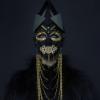 Submitted by Magia on
Submitted by Magia on

pixabay.com
By Linzi Bootman
http://paranormal-association.com/the-dark-side-of-childhood-stories/
Dropping dead from the plague, losing your head, and being raped are not typical themes in the stories we read as children. We are much more accustomed to fairytales that end in happily-ever-after and nursery rhymes that seem a little nonsensical but certainly not threatening. The origins of our nursery rhymes and fairy stories, however, display far more darkness than we expect.
Why is this? It is important to understand that songs and stories were once people’s only entertainment, adults as well as children. In addition to entertainment, nursery songs often had hidden meanings used by oppressed people to express thoughts they could not express freely for fear of persecution.
Consider “Baa Baa Black Sheep.” The song actually describes the British wool industry during the time of King Edward I. Edward I was the Plantagenet king and the ‘master’ in the rhyme. He imposed a tax on exported wool in 1275 that confiscated a third of all wool that left England. Tax collectors were based at every port in England. The “black sheep” in the poem describes tax evaders intending to smuggle wool out of the country. Once challenged, the “black sheep” is forced to declare he has three bags of wool, including ‘one for the master’, King Edward.
Some nursery songs have hidden religious meanings, like “Mary Had a Little Lamb”. The poem runs: “Mary had a little lamb, / Its fleece was white as snow / And everywhere that Mary went / The lamb was sure to go.” It is theorized that the lamb is based on Jesus. In John 1:29 it says: “the next day John saw Jesus comingtowards him and said, ‘Look, the lamb of God, who takes away the sin of the world!'” “Mary” in the poem is Jesus’ mother, the Virgin Mary. “Fleece was white as snow” refers to the purity of Jesus. The last line describes how the Holy Spirit is always around us: “Everywhere that Mary, went the lamb was sure to go.”
While the origins of many fairy tales and nursery songs are centuries old and shrouded in mystery and hidden meanings, others are actually more modern and less dark than some people want to believe. “Ring o Ring a Roses” (AKA Ring Around the Rosie), despite the widely held belief that it is about the plague that made its way across Europe during the Dark Ages, actually dates from 1881, and many theories suggest it had nothing to do with the plague at all. It appeared too late for one thing, and the symptoms and rituals that proponents of the plague theory claim the song describes do not actually match the symptoms and customs surrounding the black plague. In Europe in the 19th century, the word “fall” could also mean “to curtsy”, which brings the song still further from its allegedly dark origins. The persistent rumour that the poem is plague-related is simply an urban myth or old wives’ tale that refuses to die down.
It's not only nursery rhymes but also fairytales that have softened and sweetened over time. Most of us grew up with the idea that fairytales end in meeting Prince Charming or saving the princess from the tower, but not all tales are so nice. There has been a recent trend in putting a new spin on old stories, such as with ABC’s “Once Upon a Time” or the new movie about Hansel and Gretel. But some of our favorites like “Sleeping Beauty” have rather nasty origins. Most of us know the story of the lovely princess cursed to prick her finger on a spindle and sleep for 100 years until a prince rescues her with true love’s kiss, waking her up to live happily ever after. The original tale is not so sweet. It is a prophecy rather than a curse that puts her to sleep, and it’s not a kiss that wakes her. The king (her own father) sees this Sleeping Beauty and rapes her. After nine months, she actually gives birth to two of the kings children. One of the children sucks on her mother’s fingers, which removes a piece of flax that was keeping her asleep. Sleeping Beauty awakens to find herself raped and a mother of two.
The Brothers Grimm version of Cinderella is similarly shocking. In the modern tale, we see the beautiful serving girl Cinderella prove her identity by fitting her foot in the glass slipper so she can be swept off her feet by Prince Charming to live happily ever after. In the Grimms’ version, the nasty step-sisters cut off their own feet to fit the famous glass slipper and fool the prince into thinking it fits them perfectly. Two pigeons alert the prince of the step-sisters’ plot, and then the two pigeons peck out the sisters’ eyes, leaving them blind. The step-sisters spend the rest of their lives as blind beggars while Cinderella lounges about in luxury in the prince’s castle.
Why is it that we are so interested in the darkness we find in the origins of fairytales and nursery songs? Perhaps it is simply human nature to be curious. But then again, perhaps there is something in our modern lives that inspires in us a fascination with that darkness and a desire to seek out the mystery behind what we once saw as happy-ever-after stories and nonsense songs.
Linzi Bootman is a paranormal enthusiast, she enjoys hunting for ghosts in her spare time. Enjoys research and is a self proclaimed geek. Please feel free to contact her at linzi.bootman@yahoo.com